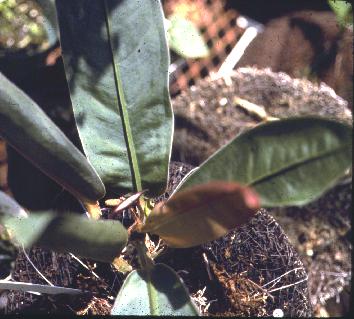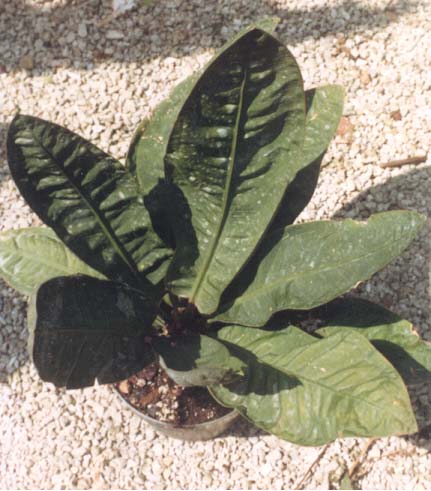
Anthurium willifordii in cultivation
photo courtesy and © 1999 of Dewey Fisk
Anthurium willifordii Croat Ann. Missouri Bot. Gard. 78:752-753
Etymology: Honoring Jack Williford, of Brandon, Florida. Mr. Williford made the first collections of this species.

Distribution: Endemic to Loreto Dept. in Peru.
Sectional Placement: This species is a member of section Pachyneurium.
Description: Planta epiphytica; internodia brevia, 1-2 cm diam.; cataphyllum persistens intactum mox deciduum; petiolus quadrangularis ad trapeziformis, interdum subteres, 2-4.5 cm longus, 4-5 mm diam.; lamina oblanceloata aut oblanceolata-elliptica, (14)18-50 cm longa, 5.5-16 cm lata; nervis primariis lateralibus 6-13 utroque; pedunculus 2.5-9 cm longus; spatha erecta, atropurpureus navicularis, 2.3-4 cm longa, 1-2 cm lata; spadix dilute purpureo-violaceum aut griseo-purpureum, cylindroideus, 1.7-4 cm longus, 2-5 mm diam.; baccae magentae.
Epiphytic herb, Stems, with short internodes with numerous dense roots speading to descending; Leaves with short petioles (2-4.5 cm long, blade moderatly coriaceous, oblanceolate to oblanceolate-elliptic forming a 'birdsnest' habit, upper surface matte and velvety and slightly quilted, lower surface slightly crystalline, matte and sometimes tinged with red; Inflorescence, erect, peduncle 2.5-9 cm long, 1.5-3 times as long as petiole, spathe erect, green tinged with purple, spadix reddish to faintly purple-violet, erect and very short, Berries, scattered on the spadix and magenta in color.
A more detailed description of this species can be found in A Revision of Anthurium Section Pachyneurium.
Notes: A very beautiful species which is in great demand with collectors. The tight birdsnest habit and velvety, quilted blades are some of the characterisics which set this species off from many of the other birdsnests. This species is notorious as difficult to cultivate with some people seemingly having no trouble and others having no luck at all. Now in tissue culture, more should become available to try out.
Bottom photo courtesy and © 1999 Rick Cirino.
Copyright © 2007 by Neil Carroll. All rights reserved.
BACK TO THE SPECIES LIST